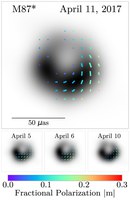Polarimetric Imaging of M87
 The Event Horizon Telescope (EHT), featuring the Atacama Large Millimeter/submillimeter Array (ALMA) as its anchor element, has presented their polarimetric imaging at 240 GHz around the supermassive black hole in M87 on event-horizon scales. This polarized synchrotron radiation probes the structure of magnetic fields and the plasma properties near the black hole. The field geometry appears as a spiral. The fractional polarization is low (<20%), indicating high Faraday rotation, from which the research team estimates ne ∼ 104-7 cm-3, B ∼ 1-30 G, and Te ∼ (1-12) × 1010 K, in the radiating plasma.
The Event Horizon Telescope (EHT), featuring the Atacama Large Millimeter/submillimeter Array (ALMA) as its anchor element, has presented their polarimetric imaging at 240 GHz around the supermassive black hole in M87 on event-horizon scales. This polarized synchrotron radiation probes the structure of magnetic fields and the plasma properties near the black hole. The field geometry appears as a spiral. The fractional polarization is low (<20%), indicating high Faraday rotation, from which the research team estimates ne ∼ 104-7 cm-3, B ∼ 1-30 G, and Te ∼ (1-12) × 1010 K, in the radiating plasma.
The collaboration shows that the net azimuthal linear polarization pattern may result from organized, poloidal magnetic fields in the emission region. In a quantitative comparison with a large library of simulated polarimetric images from general relativistic magnetohydrodynamic (GRMHD) simulations, the authors identify a subset of physical models that can explain critical features of the polarimetric EHT observations while producing a relativistic jet of sufficient power. The consistent GRMHD models are all of magnetically arrested accretion disks, where near-horizon magnetic fields are dynamically important. Models enable the team to infer a mass accretion rate onto the black hole in M87 of (3-20) × 10-4 M⊙ yr-1. Strong fields may also be key to the physics of relativistic jet launch.
Image Caption: EHT 240 GHz images of total intensity, and fractional polarization and position angle in M87.
Publication: Event Horizon Telescope Collaboration, First M87 Event Horizon Telescope Results. VIII. Magnetic Field Structure near The Event Horizon, Astrophysical Journal Letters, 910, L13 (March 2021).
NRAO Press Release: New Image Reveal Magnetic Structures Near Supermassive Black Hole




Connect with NRAO